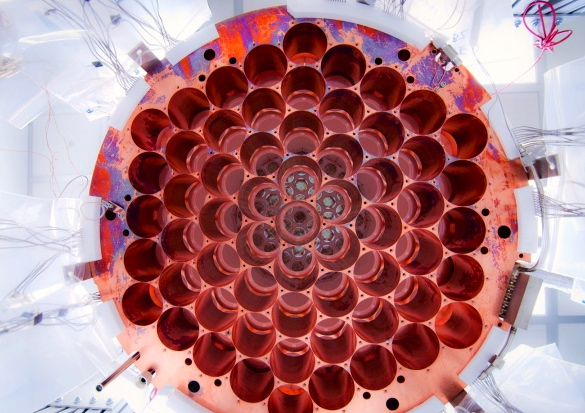
Science Journal Nature Names LUX as a Scientific Highlight of the Year
The premier European science journal Nature opened its annual year-end special “365 DAYS: the year in science” with the Large Underground Xenon (LUX) experiment, the most sensitive dark matter detector in the world. A team of scientists from UC Santa Barbara has been instrumental in the design, construction and filling of the sophisticated water tank that houses the LUX experiment.
LUX is situated 4,850 feet underground at South Dakota’s Sanford Lab where few cosmic ray particles can penetrate. The detector is further protected from background radiation emanating from the surrounding rock by immersion in the tank of ultrapure water.
Dark matter is currently known only through its gravitational pull on conventional matter seen in astronomical observations. LUX, which contains more than 300 kilograms of liquid xenon, seeks to catch dark matter particles as they pass through Earth and hit xenon nuclei. This collision would cause flashes of light detectable by LUX’s 122 photomultiplier tubes.
According to Nature’s year in review, while LUX “did not see any particles of elusive dark matter flying through Earth…it put the tightest constraints yet on the mass of dark-matter particles and their propensity to interact with visible matter.”
“It is a tremendous honor for the LUX result to be highlighted by Nature, the venerable scientific journal with the highest impact in terms of citations, and one of the very few journals that reports cutting-edge research across a wide variety of fields,” said UCSB physicist Harry Nelson, principal investigator of the UCSB LUX team. “Progress toward directly detecting the dark matter of the universe has been exciting lately, and we hope that in the near future Nature can highlight our success in finally ‘touching’ that mysterious stuff, which makes up 85 percent of matter in our universe.”
“We were pleased and surprised to get such a strong response from our first paper, which was based on a short run of 85 days with the experiment,” said UCSB LUX team principal investigator Mike Witherell, vice chancellor for research and a professor in the Department of Physics. “In 2014 we are going to be conducting a 300-day run from which we will get even more sensitive results.”
In addition, the proposal for an experiment 20 times the size of LUX has just been submitted. This experiment, called LUX-Zeplin (LZ), would contain 7 tons of xenon inside the same 72,000-gallon tank of pure water used by LUX. The LZ collaboration has just named UCSB’s Nelson to take over as spokesperson in the summer of 2014. “I’ve been lucky to be chosen by my research colleagues on this successor experiment to LUX where we hope to achieve more than 100 times better sensitivity.”
“Nelson will be stepping down from his current role as chair of the LUX executive board to lead construction project for the LZ instrument, coordinating the efforts of 25 participating institutions in Europe and the U.S.,” Witherell said. “We think we have a good chance of a big discovery with LZ. We hope that these early LUX results will strengthen our case.”
In addition to principle investigators Nelson and Witherell, the UCSB LUX Team includes postdoctoral scholar María del Carmen Carmona Benítez, graduate students Curt Nehrkorn and Scott Haselschwardt and engineers Susanne Kyre and Dean White.
The UCSB LUX group is supported by the Department of Energy Office of High Energy Physics and by UCSB.



